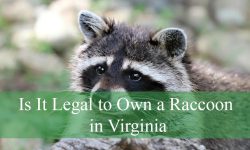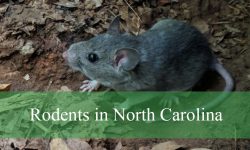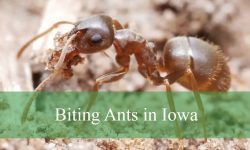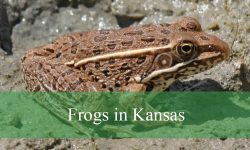Delaware hosts a rich variety of bird species, from vibrant songbirds to impressive raptors. Its mix of coastal areas, forests, wetlands, and suburban landscapes provides ideal habitats for both resident and migratory birds.
Birdwatchers and nature enthusiasts can spot backyard favorites like Northern Cardinals and American Robins, alongside less common species such as Ospreys and Bald Eagles. Each bird plays a unique role in Delaware’s ecosystems, from pollination to pest control.
This guide presents 46 common birds in Delaware, with detailed information on identification, size, behavior, and habitat. It is designed to help you recognize and learn about the state’s most notable avian residents.
Most Common Birds Found in Delaware
White-breasted Nuthatch
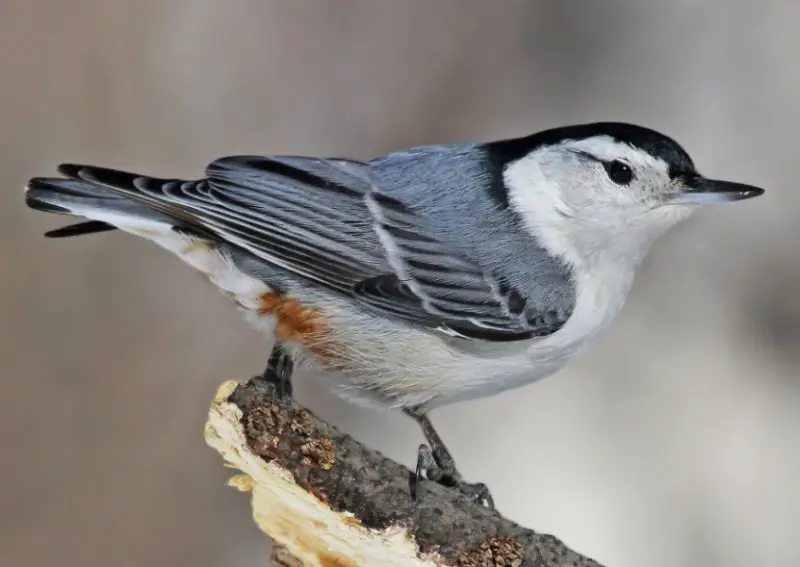
The White-breasted Nuthatch is a distinctive bird in Delaware, recognized by its blue-gray back, white face and underparts, and black cap that extends down the nape. It measures about 5 to 6 inches in length with a wingspan of 8 to 10 inches. Its compact body and strong bill make it well-adapted for foraging along tree trunks and branches.
This species is well known for its unique behavior of creeping headfirst down trees in search of insects and seeds, a trait that sets it apart from many other songbirds. They are also known to store food in bark crevices for later consumption. Their nasal “yank-yank” calls are a common sound in wooded areas and help them communicate within pairs or family groups.
In Delaware, White-breasted Nuthatches are widespread year-round, inhabiting deciduous forests, parks, and suburban areas with mature trees. They often join chickadees and titmice in mixed winter flocks, providing both company and safety in numbers. Their presence adds to the lively bird activity in Delaware’s woodlands and neighborhoods.
Northern Cardinal
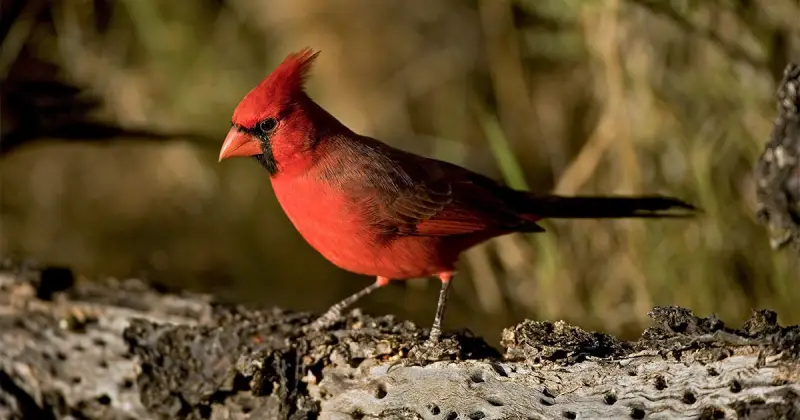
The Northern Cardinal is one of the most striking birds in Delaware, recognized by its brilliant red plumage in males and warm brown coloration with red highlights in females. Both sexes feature a distinctive crest atop their heads and a stout orange-red beak that is easily noticeable even from a distance. Measuring around 8 to 9 inches in length with a wingspan of 10 to 12 inches, these birds are medium-sized songbirds that stand out in both woodlands and suburban yards.
Behaviorally, Northern Cardinals are known for their strong territorial instincts and melodic whistling songs, often performed by both males and females. They feed primarily on seeds, berries, and insects, frequently visiting bird feeders where sunflower seeds are a favorite. Males are especially protective of their nesting areas, sometimes even attacking their reflection in windows, mistaking it for a rival.
In Delaware, Northern Cardinals are widespread and common throughout the year, thriving in mixed woodlands, parks, gardens, and residential areas. Their adaptability to human presence and preference for thick shrubs and trees for nesting make them well-suited to both urban and rural environments. They are permanent residents, ensuring that their bright colors bring life to the winter landscapes of Delaware.
Blue Jay
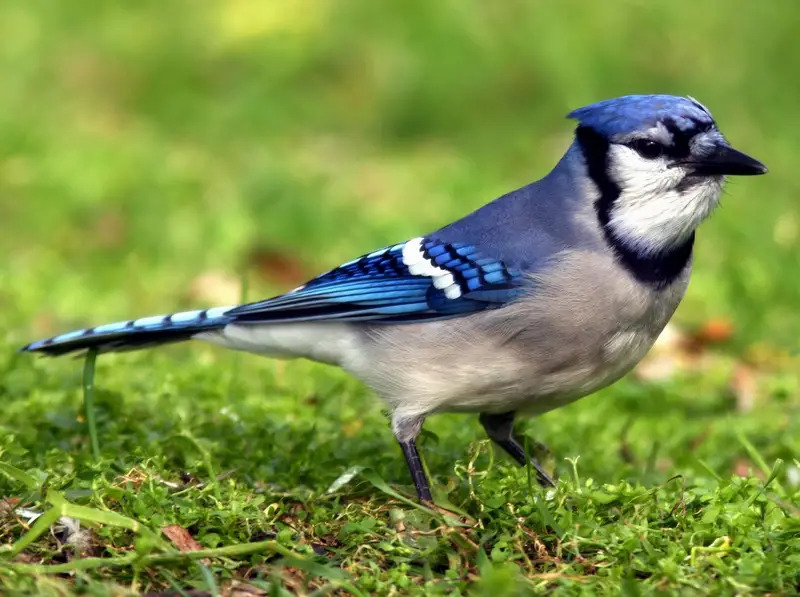
The Blue Jay is a bold and intelligent bird that is hard to miss in Delaware with its striking blue plumage, white face, and black necklace-like markings across the throat and head. Measuring about 9 to 12 inches long with a wingspan of 13 to 17 inches, Blue Jays are medium to large songbirds. Their crested heads and loud calls make them one of the more conspicuous species in the region.
Their behavior is equally fascinating, as Blue Jays are known for their intelligence, complex communication, and sometimes aggressive interactions with other birds. They are skilled mimics, often imitating the calls of hawks, which can confuse or alarm other species. Their diet is varied, consisting of acorns, nuts, insects, and occasionally small vertebrates. They also cache food for later use, a behavior that aids in forest regeneration when forgotten acorns sprout into oak trees.
Blue Jays are common year-round in Delaware, favoring mixed woodlands, oak groves, and suburban neighborhoods with mature trees. They are particularly noticeable during autumn when large groups may migrate, although many remain in the state throughout winter. Their adaptability and boldness make them a familiar and charismatic presence across Delaware’s landscapes.
American Robin

The American Robin is one of the most familiar birds in Delaware, easily recognized by its bright orange-red breast, dark gray back, and white eye ring. Measuring between 9 and 11 inches long with a wingspan of 12 to 16 inches, this species is a medium-sized thrush. Its cheerful presence and distinctive plumage make it a favorite sight in yards, fields, and parks.
Robins are known for their behavior of hopping across lawns in search of earthworms, a staple in their diet during the warmer months. They also consume insects, fruits, and berries, especially in fall and winter. Their clear, melodious song is one of the earliest bird sounds heard in Delaware each spring, signaling the change of seasons.
In Delaware, American Robins are abundant year-round but especially prominent during the breeding season in spring and summer. They nest in trees, shrubs, or even man-made structures, often returning to the same sites year after year. During colder months, they form large flocks that forage for berries, roaming woodlands, farmlands, and residential areas throughout the state.
Mourning Dove
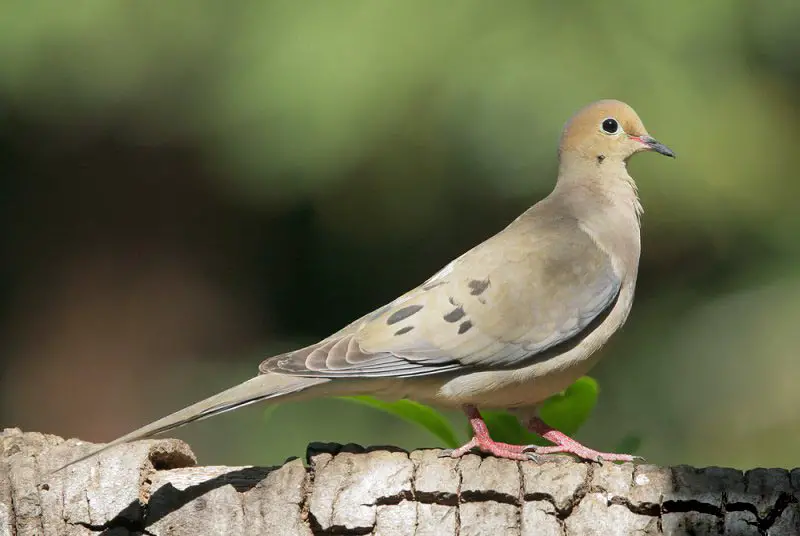
The Mourning Dove is a graceful and slender bird, recognized in Delaware by its light brown body with black wing spots, long pointed tail edged with white, and soft blue-gray wings. They measure about 9 to 13 inches in length with wingspans ranging from 17 to 18 inches, making them medium-sized doves. Their mournful cooing calls give them their name and are a common sound across the state.
Behaviorally, Mourning Doves are known for their fast, direct flight with whistling wing sounds. They primarily feed on seeds, often foraging on the ground in open areas, fields, and backyards. These doves are prolific breeders, raising several broods each year during the warm months. Their nests are typically flimsy platforms of twigs placed in trees, shrubs, or sometimes on man-made structures.
In Delaware, Mourning Doves are widespread and can be found in rural farmlands, suburban neighborhoods, and even city parks. They are year-round residents, with their adaptability allowing them to thrive in a variety of habitats. Their abundance and gentle presence make them one of the most frequently observed birds in the state.
Red-bellied Woodpecker
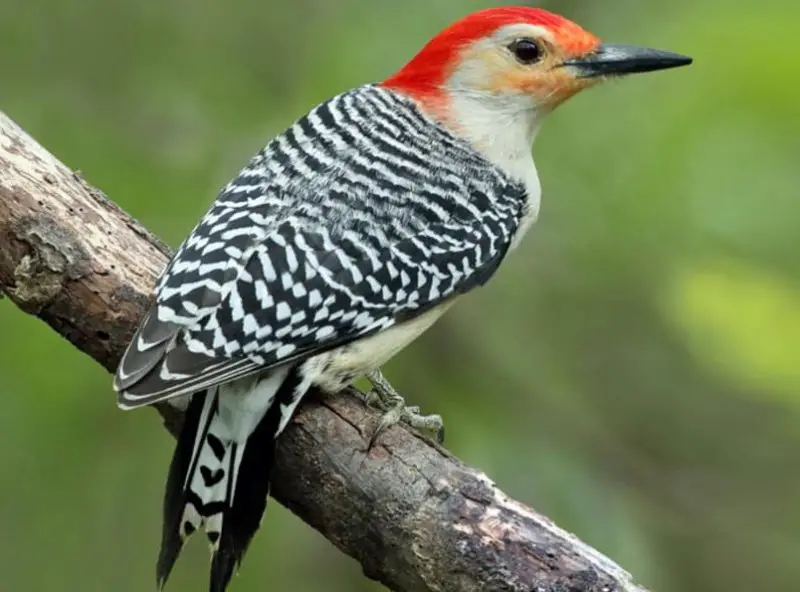
The Red-bellied Woodpecker is a striking bird in Delaware, identified by its black-and-white barred back, pale underparts with a faint reddish tinge on the belly, and a bright red cap extending over the head in males. Females display similar markings, though the red is usually confined to the nape. They measure around 9 to 10.5 inches in length with a wingspan of 13 to 17 inches, making them medium-sized woodpeckers.
Their behavior is energetic and resourceful, as they cling to tree trunks and branches while searching for insects, nuts, and fruits. They also store food in bark crevices, especially during fall and winter. Their rolling “churr” call is a familiar sound in wooded areas, and they frequently visit backyard feeders, especially those offering suet or peanuts.
In Delaware, Red-bellied Woodpeckers are common year-round residents, thriving in deciduous forests, wooded suburbs, and parks. They prefer areas with mature trees, where they can excavate nest cavities and forage effectively. Their adaptability to both natural woodlands and human-influenced environments ensures their widespread presence throughout the state.
Downy Woodpecker
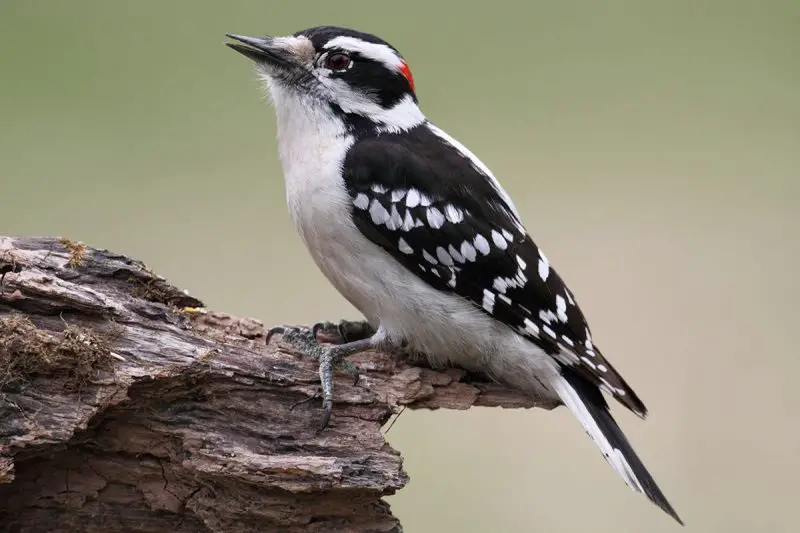
The Downy Woodpecker is the smallest woodpecker in Delaware, measuring only 5.5 to 7 inches long with a wingspan of 9 to 12 inches. It can be identified by its black-and-white checkered pattern, white underparts, and a white stripe down the back. Males have a small red patch on the back of the head, while females lack this marking. Despite its size, it closely resembles the larger Hairy Woodpecker, though with a shorter bill.
Downy Woodpeckers exhibit lively behavior, often clinging to tree trunks and small branches as they forage for insects, larvae, and seeds. They frequently visit backyard feeders, especially for suet and sunflower seeds, making them one of the most approachable woodpecker species. Their high-pitched “pik” call and drumming are common sounds in wooded and suburban areas.
In Delaware, Downy Woodpeckers are year-round residents, found in forests, orchards, parks, and residential areas with trees. Their adaptability allows them to thrive in both natural and human-dominated landscapes. Their small size and active movements make them a delightful and frequent visitor to bird feeders across the state.
Carolina Chickadee
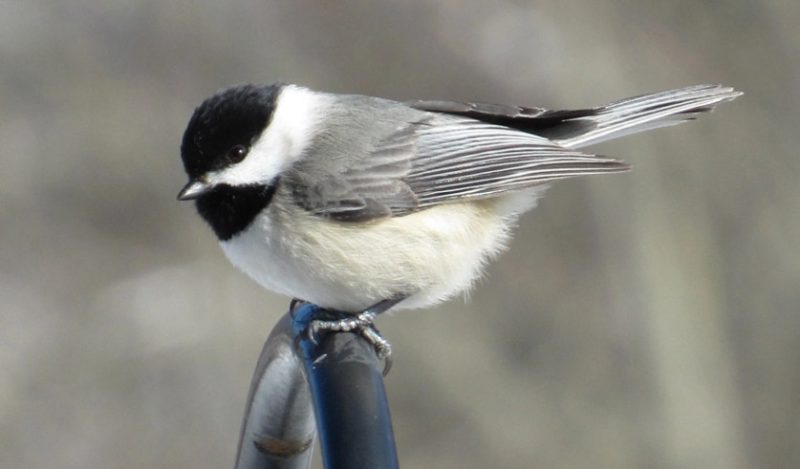
The Carolina Chickadee is a small, energetic bird found across Delaware, measuring only 4.5 to 5 inches long with a wingspan of 6 to 8 inches. It is easily identified by its black cap and throat, white cheeks, soft gray back, and pale underparts. Its quick movements and constant activity make it a charming bird to watch in wooded and suburban areas.
Carolina Chickadees are highly social and often travel in mixed flocks with titmice, nuthatches, and woodpeckers during the winter months. They feed on insects, seeds, and berries, frequently visiting backyard feeders for sunflower seeds and suet. Their distinctive “chick-a-dee-dee-dee” call is both a form of communication and a way to warn others of predators.
In Delaware, these chickadees are year-round residents, thriving in deciduous forests, parks, and neighborhoods with mature trees. They often nest in tree cavities or birdhouses, making them a welcome visitor in gardens. Their adaptability and lively presence make them a common and beloved songbird across the state.
Tufted Titmouse
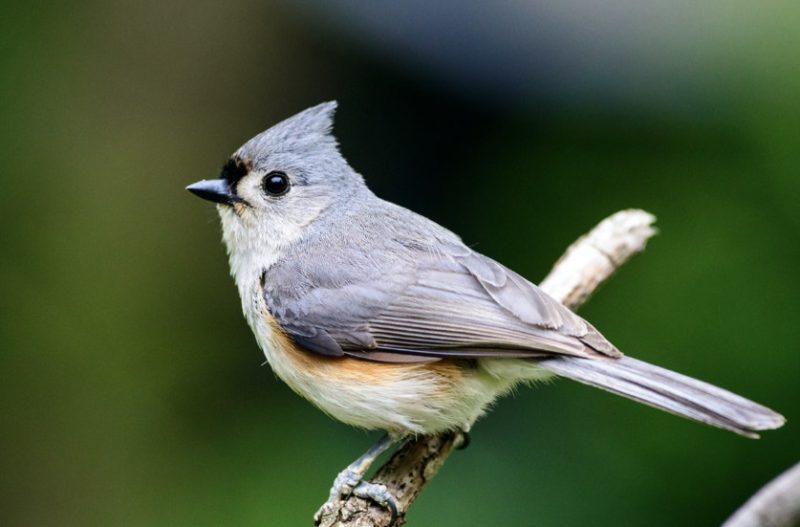
The Tufted Titmouse is a small but bold bird in Delaware, identified by its gray upperparts, pale underparts, large black eyes, and a noticeable crest on its head. Measuring about 6 to 6.5 inches long with a wingspan of 8 to 10 inches, it is slightly larger than a chickadee but just as active and charming. Its sharp black beak and rust-colored flanks add to its distinct appearance.
These birds are curious and vocal, often heard before they are seen due to their clear “peter-peter-peter” song. Tufted Titmice feed on insects, seeds, and nuts, often hoarding food in hidden spots for later use. They are frequent visitors at backyard feeders, showing little fear as they snatch sunflower seeds and carry them away to crack open.
In Delaware, Tufted Titmice are year-round residents, common in deciduous woodlands, suburban gardens, and parks with tall trees. They often join mixed-species flocks in winter, traveling alongside chickadees and nuthatches. Their bold nature and charming calls make them a familiar sight throughout the state.
Carolina Wren
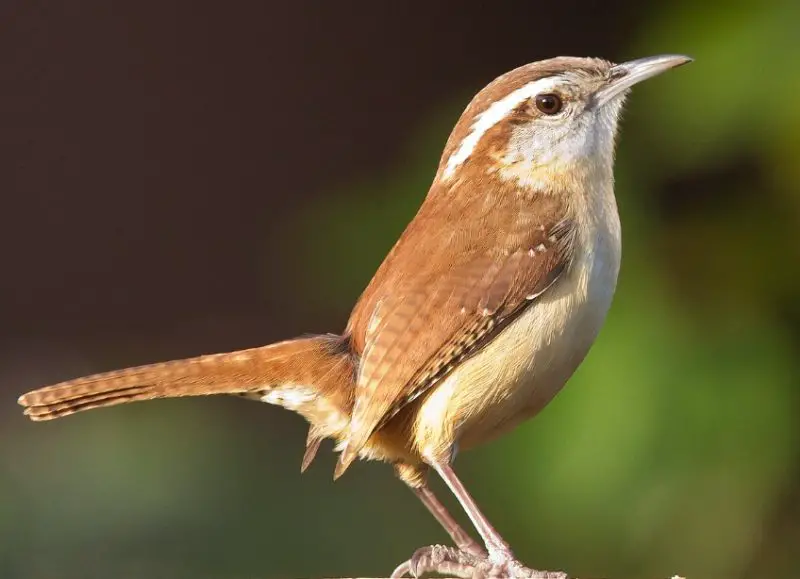
The Carolina Wren is a small but bold bird that thrives in Delaware, easily recognized by its rich reddish-brown plumage, buff-colored underparts, and distinctive white eyebrow stripe. Measuring about 5 to 5.5 inches in length with a wingspan of 11 inches, it is slightly stocky with a rounded body and long tail often held upright.
Carolina Wrens are known for their loud, musical songs that seem much larger than their body size. They feed on insects, spiders, and small fruits, often probing into crevices and leaf litter. Their curious and active behavior makes them frequent visitors to yards, where they explore woodpiles, shrubs, and even porches in search of food or nesting sites.
In Delaware, Carolina Wrens are permanent residents, especially abundant in wooded edges, thickets, and residential areas with dense vegetation. They often build nests in unusual places, such as hanging baskets, sheds, or mailboxes. Their year-round singing and adaptability make them one of the most noticeable wrens in the state.
Eastern Bluebird
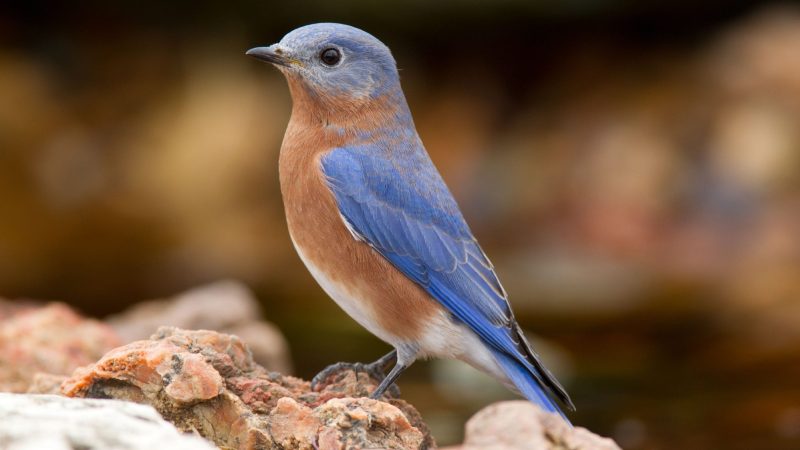
The Eastern Bluebird is a symbol of beauty and hope in Delaware, identified by its brilliant blue upperparts, rusty red throat and breast, and white belly. Females have duller blue wings and grayer tones but share the same elegant pattern. They measure about 6.5 to 8 inches long with a wingspan of 9 to 12 inches, making them medium-sized thrushes.
Eastern Bluebirds are cavity nesters, often using old woodpecker holes or nest boxes placed by people. Their diet consists of insects during spring and summer, shifting to berries and fruits in colder months. They are often seen perched on wires, posts, or low branches, scanning the ground for prey before swooping down to catch it.
In Delaware, Eastern Bluebirds are fairly common year-round, thriving in open fields, meadows, orchards, and suburban gardens with nest boxes. Their populations have increased thanks to conservation efforts and the popularity of bluebird trails. Their bright colors and gentle songs make them one of the most cherished birds in the state.
House Finch
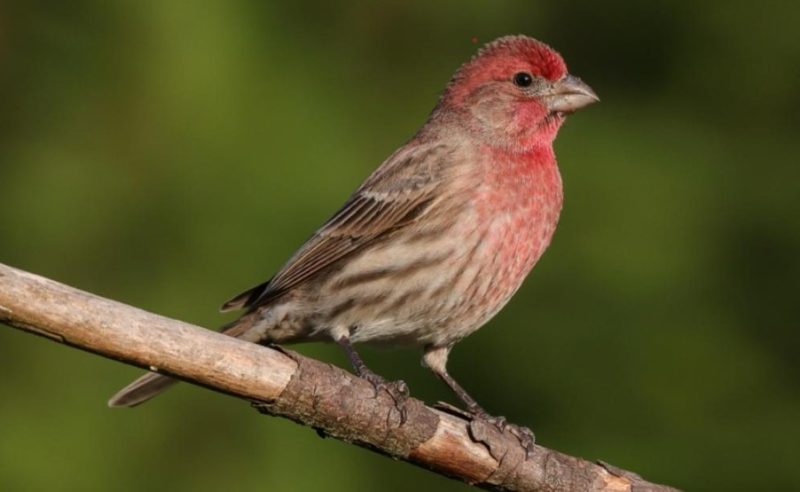
The House Finch is a familiar bird in Delaware, with males displaying rosy-red coloring on the head, throat, and chest, while females are streaked brown and lack bright hues. Both sexes share a conical beak suited for seed eating, and they measure about 5 to 6 inches long with a wingspan of 8 to 10 inches. Their streaky patterns and cheerful songs make them a common sight.
These finches are social and often gather in flocks, especially around feeders where they consume sunflower seeds, fruits, and buds. Their lively warbling songs and chattering calls bring energy to suburban areas. They are adaptable birds, thriving in both rural and urban environments.
In Delaware, House Finches are year-round residents, found in cities, towns, farmlands, and backyards. Originally native to the western United States, they have successfully expanded across the East. Their adaptability and friendly presence at feeders make them one of the most frequently observed small songbirds in the state.
American Goldfinch
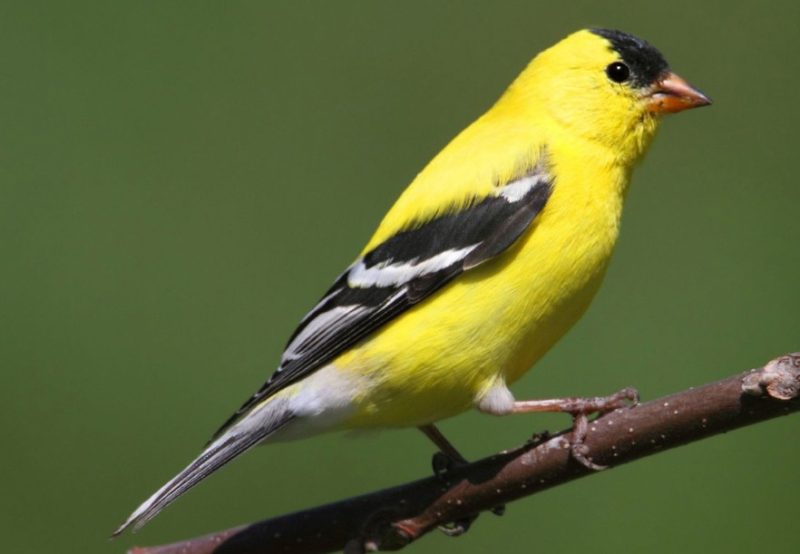
The American Goldfinch is a small, vibrant bird found throughout Delaware, instantly recognizable by the bright yellow plumage of males in summer, accented with black wings and a black cap. Females and winter males are more subdued, with olive-brown tones, though still displaying the distinctive wing markings. Measuring 4.5 to 5 inches long with a wingspan of 7.5 to 8.5 inches, these finches are among the most colorful songbirds in the state.
Goldfinches are primarily seed-eaters, preferring thistle, sunflower, and other native wildflower seeds. They often visit backyard feeders and are one of the few birds that molt into a completely different plumage between seasons. Their flight is bouncy, accompanied by a cheerful “per-chick-o-ree” call that adds liveliness to meadows and gardens.
In Delaware, American Goldfinches are year-round residents, thriving in open fields, weedy edges, and suburban backyards. They breed later in the season compared to most songbirds, often waiting until midsummer when seeds are plentiful. Their adaptability to both wild and human-influenced habitats makes them a familiar and welcome sight across the state.
Song Sparrow
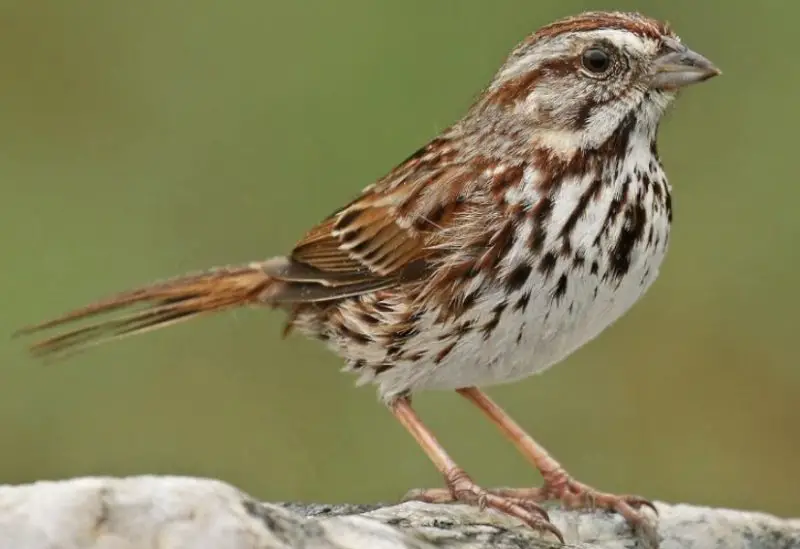
The Song Sparrow is one of Delaware’s most widespread sparrows, identified by its streaky brown plumage, gray face with a central dark stripe, and a distinctive dark spot on the breast. They measure about 5.5 to 7 inches in length with a wingspan of 7.5 to 9 inches. Though plain at first glance, their detailed markings and rich song make them easily recognizable.
These sparrows are named for their melodious and varied songs, often heard from fence posts, shrubs, or low trees. They feed on seeds and insects, foraging on the ground or in dense vegetation. Song Sparrows are adaptable and can often be found near water, in brushy fields, and in suburban gardens.
In Delaware, Song Sparrows are year-round residents, although numbers increase in fall and winter when migrants join local populations. Their ability to thrive in diverse habitats makes them one of the most commonly encountered sparrows across the state. Their persistent singing adds to the soundscape of Delaware’s fields and backyards.
White-throated Sparrow
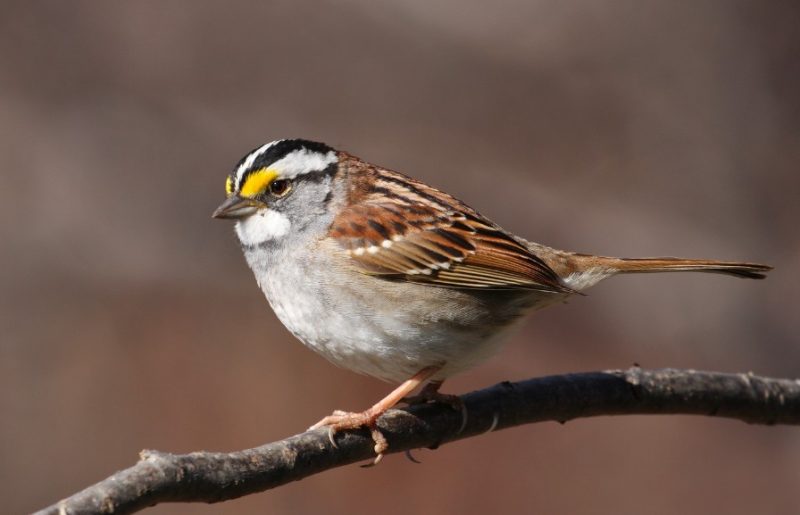
The White-throated Sparrow is a handsome bird that winters in Delaware, known for its bold white throat patch, yellow spots between the eyes and bill, and black-and-white striped crown. Some individuals have a tan-striped variation, but both forms share the same crisp markings. They measure about 6.5 to 7.5 inches long with a wingspan of 9 inches, making them medium-sized sparrows.
These sparrows are ground foragers, feeding on seeds, berries, and insects, often scratching through leaf litter beneath shrubs and trees. Their sweet, whistled song is well known and often described as sounding like “Old Sam Peabody, Peabody, Peabody.” They are sociable in winter, frequently forming flocks with other sparrow species.
In Delaware, White-throated Sparrows are abundant during fall, winter, and early spring, especially in woodlands, brushy edges, and suburban backyards with dense cover. They migrate north to breed in Canada and the northern United States during summer. Their cheerful presence makes them a familiar winter visitor across the state.
Dark-eyed Junco
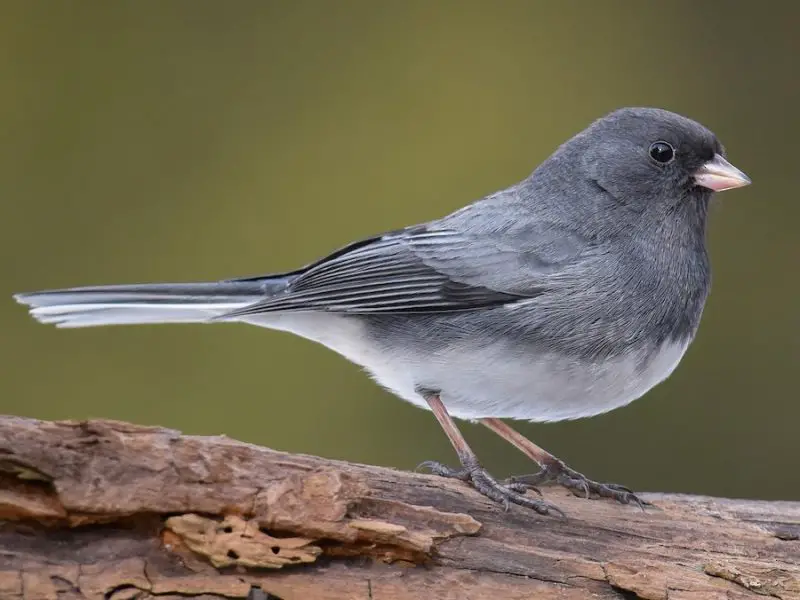
The Dark-eyed Junco is a familiar winter bird in Delaware, often called “snowbirds” because of their arrival in large numbers during colder months. They are small sparrow-like birds, about 5 to 6.5 inches in length with a wingspan of 7 to 10 inches. Juncos are easily recognized by their slate-gray plumage, white belly, and distinctive flashing white tail feathers in flight.
Their behavior is lively and social, as they forage in flocks on the ground, scratching for seeds and occasionally visiting feeders. They prefer open wood edges, fields, and backyards with scattered shrubs. Their sharp “tik” calls and constant movement make them an active presence during winter days.
In Delaware, Dark-eyed Juncos are common winter residents but migrate northward in spring to breed in Canada and higher elevations. Their seasonal appearance makes them a reliable sign of winter in the state, often gathering in flocks that brighten snowy fields and suburban neighborhoods.
Northern Mockingbird
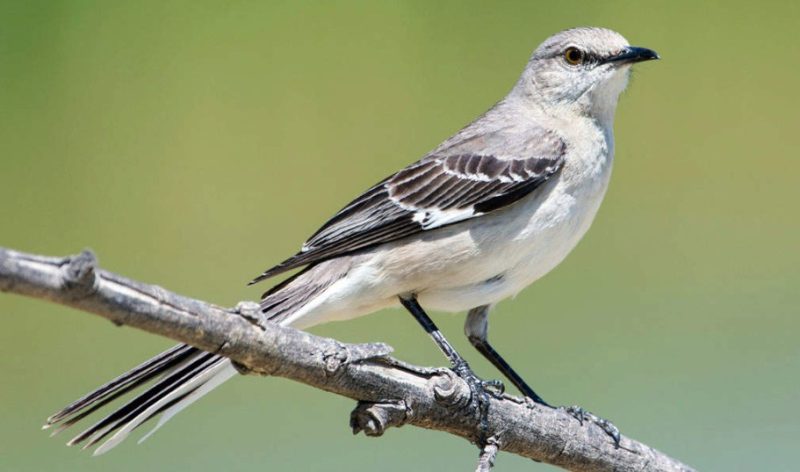
The Northern Mockingbird is a slender gray bird with white wing patches and tail edges, measuring 8 to 10 inches long with a wingspan of 12 to 15 inches. Its medium size, long tail, and graceful movements make it easy to identify. Both sexes look similar, showing soft gray plumage with lighter underparts.
Mockingbirds are celebrated for their vocal abilities, capable of mimicking the songs of dozens of bird species as well as other sounds such as whistles or even mechanical noises. They are highly territorial and will aggressively defend their nests and feeding areas. Their diet includes insects, berries, and fruits, making them versatile foragers.
In Delaware, Northern Mockingbirds are permanent residents, thriving in suburban neighborhoods, farmland edges, and open woodlands. They are often seen perched prominently on fences, shrubs, or posts while singing loudly. Their adaptability and remarkable singing make them one of the most charismatic songbirds in the state.
European Starling
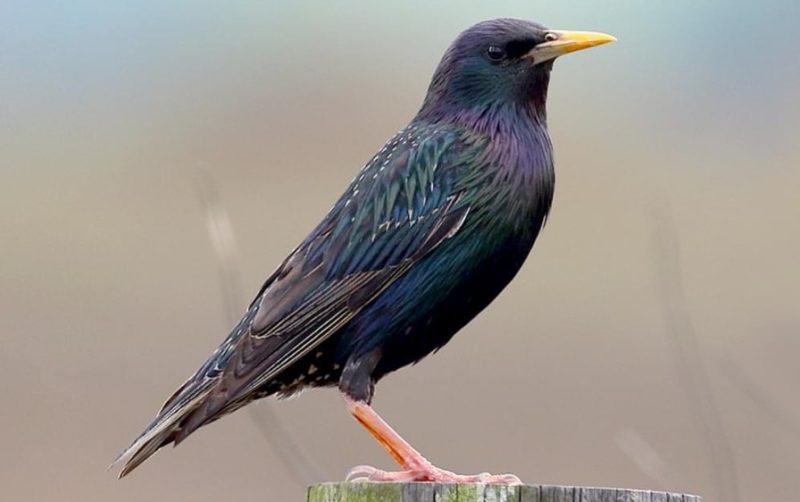
The European Starling is a widespread bird in Delaware, introduced from Europe and now one of the most abundant species in North America. Adults measure about 8 to 9 inches in length with a wingspan of 12 to 16 inches. Their glossy black plumage shines with purple and green iridescence in sunlight, while in winter they show white speckles across their feathers.
Starlings are bold, noisy, and social, often forming large flocks that move in synchronized patterns known as murmurations. They feed on insects, fruits, and seeds, frequently foraging on lawns, fields, and city streets. Their whistling and chattering calls include a wide range of imitations of other birds.
In Delaware, European Starlings are year-round residents, thriving in both urban and rural settings. They nest in cavities, often competing aggressively with native species for nesting sites. Despite their invasive status, their adaptability and striking flight displays make them a common and unmistakable presence throughout the state.
Common Grackle
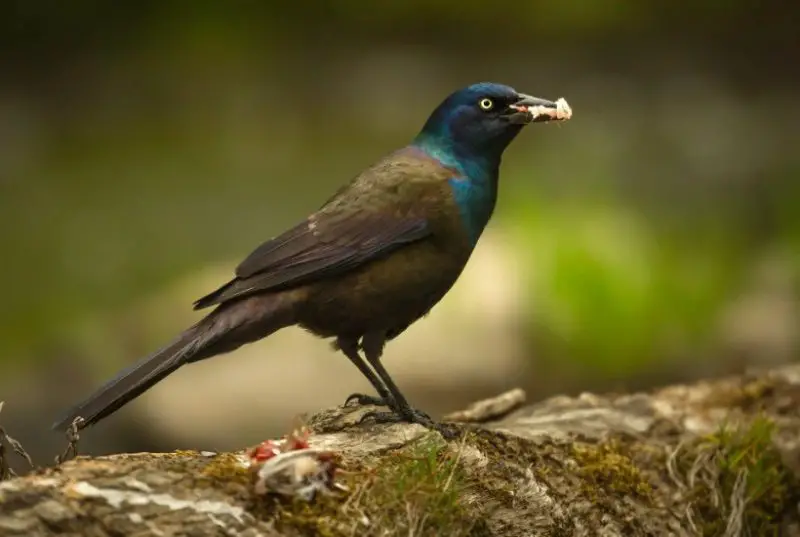
The Common Grackle is a large blackbird with striking iridescent plumage that shimmers with shades of purple, green, and blue in sunlight. Measuring about 11 to 13 inches long with a wingspan of 14 to 18 inches, it has a long keel-shaped tail and a piercing yellow eye that gives it a sharp, intense look. Its strong bill and glossy feathers make it stand out among flocks of blackbirds.
Behaviorally, grackles are bold and social, often gathering in large flocks that forage noisily in fields, lawns, and marshes. They feed on insects, seeds, fruits, and even small vertebrates, making them highly opportunistic. Their calls are harsh and metallic, contrasting with the melodious songs of other blackbirds.
In Delaware, Common Grackles are abundant during spring and summer, breeding in woodlands, wetlands, and suburban areas. Many migrate south in winter, but some remain year-round in milder parts of the state. Their adaptability and large flocks make them a familiar sight in agricultural landscapes and urban neighborhoods.
Brown-headed Cowbird
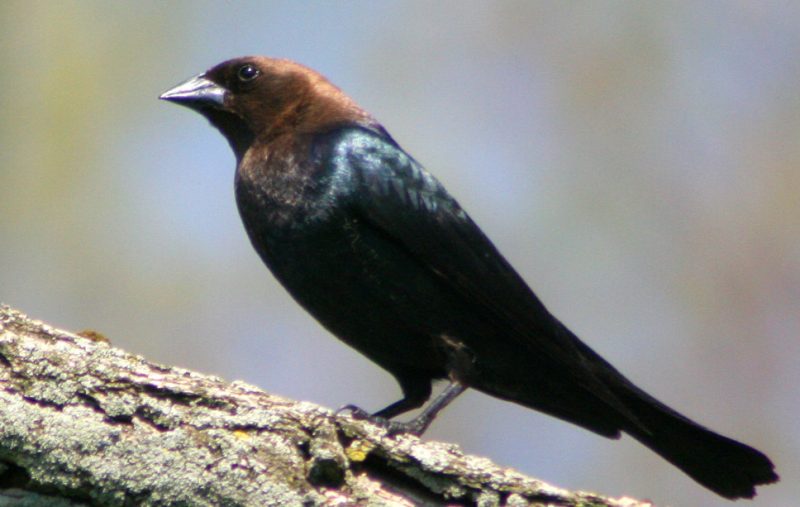
The Brown-headed Cowbird is a small blackbird recognized by the glossy black body of males with contrasting chocolate-brown heads, while females are a plain brown-gray overall. They measure about 7 to 8.5 inches long with a wingspan of 12 to 15 inches. Their short, thick bill is well-suited for eating seeds and insects.
Cowbirds are best known for their unusual breeding behavior: they are brood parasites, laying their eggs in the nests of other bird species. The unsuspecting host then raises the cowbird chick, often at the expense of its own young. Despite this, cowbirds are fascinating to observe for their social habits and adaptability.
In Delaware, Brown-headed Cowbirds are common in open fields, farmland, and suburban areas, especially during the breeding season in spring and summer. They are often seen foraging on the ground in flocks, sometimes mixed with grackles or blackbirds. Their parasitic nesting strategy has made them widespread across the state.
Red-winged Blackbird
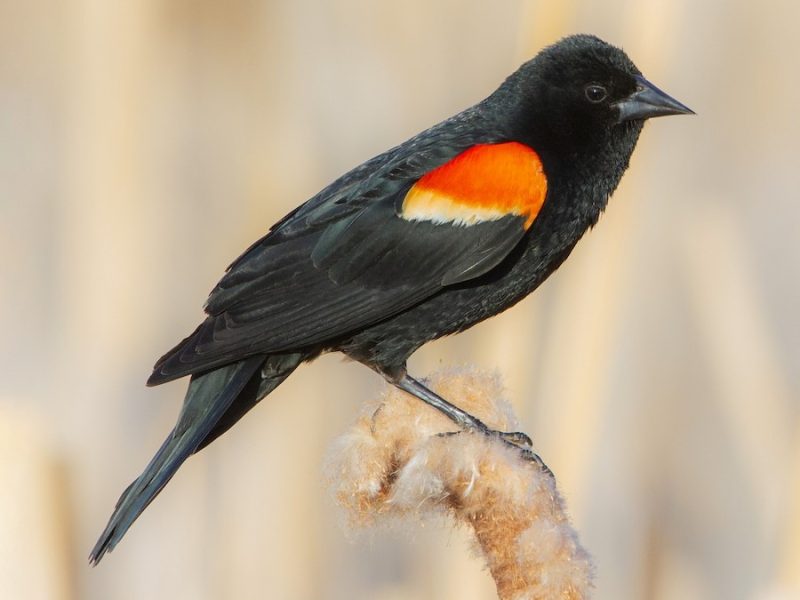
The Red-winged Blackbird is one of the most iconic birds of Delaware’s wetlands, instantly recognized by the glossy black plumage of males with bright red and yellow shoulder patches, or “epaulets.” Females look quite different, with streaky brown plumage that helps them blend into marshy vegetation. They measure 7 to 9.5 inches long with a wingspan of 12 to 16 inches.
These blackbirds are territorial and vocal, with males often singing from cattails or fence posts to defend their nesting sites. Their diet includes insects, seeds, and grains, and they often forage in flocks outside of the breeding season. Their distinctive “conk-la-ree” song is one of the most familiar sounds of marshlands.
In Delaware, Red-winged Blackbirds are common from spring through fall, especially near wetlands, ponds, and open fields. Many migrate south in winter, though some may stay in the state if conditions are mild. Their bold colors and loud songs make them one of the most recognizable birds of Delaware’s landscapes.
Baltimore Oriole
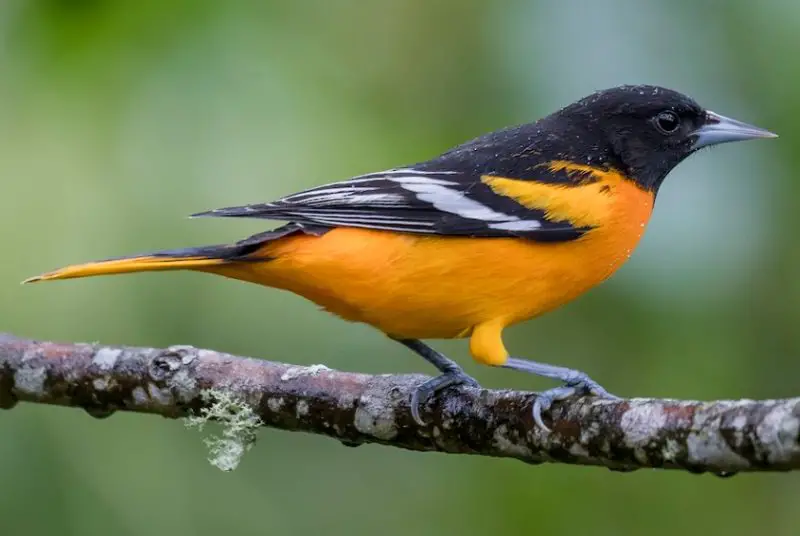
The Baltimore Oriole is a striking songbird and the state bird of Maryland, frequently seen in Delaware during the breeding season. Males are vibrant with orange underparts and black wings with white bars, while females are more subdued in yellow-orange with grayish wings. They measure 6.5 to 8 inches long with a wingspan of about 9 to 12 inches.
Baltimore Orioles are known for their woven hanging nests, often suspended from the outer branches of tall deciduous trees. They feed on insects, fruits, and nectar, and are especially attracted to oranges and grape jelly at backyard feeders. Their whistled songs are rich and melodic, adding beauty to spring mornings.
In Delaware, Baltimore Orioles are migratory, arriving in late spring and staying through summer before heading to Central and South America for the winter. They are most often found in open woodlands, orchards, and suburban neighborhoods with large shade trees. Their brilliant colors and sweet songs make them a favorite seasonal visitor.
Gray Catbird
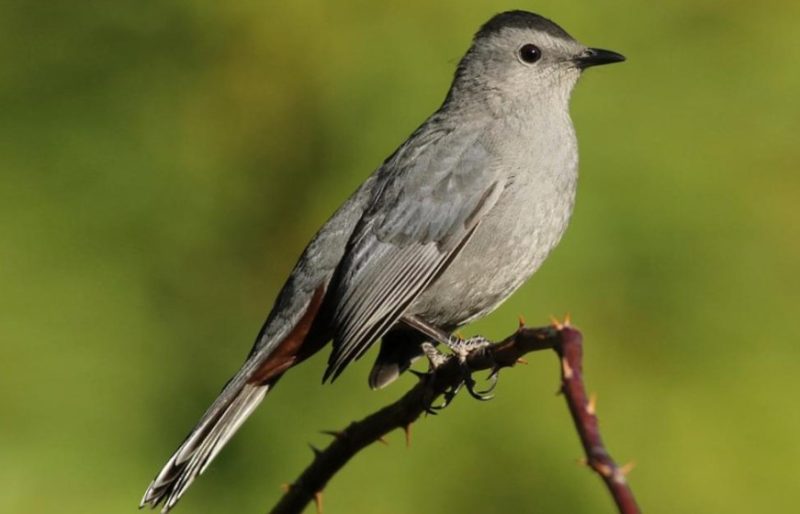
The Gray Catbird is a slender, medium-sized bird measuring about 8.5 to 9.5 inches long with a wingspan of 11 inches. Its plumage is a smooth slate-gray with a small black cap and a reddish patch under the tail. Its name comes from its cat-like “mew” call, which is a common sound in Delaware’s thickets and gardens.
Catbirds are accomplished mimics, often weaving together long strings of borrowed songs from other birds into their own complex vocalizations. They are curious and active, feeding on insects, berries, and fruits, often searching through dense shrubs for food. They are known to be bold around humans, frequently exploring backyards and gardens.
In Delaware, Gray Catbirds are summer residents, arriving in spring to breed in shrubby habitats, forest edges, and suburban yards. Many migrate south in fall, but some may linger through winter if food is available. Their vocal variety and friendly presence make them a common and entertaining bird across the state.
Eastern Towhee
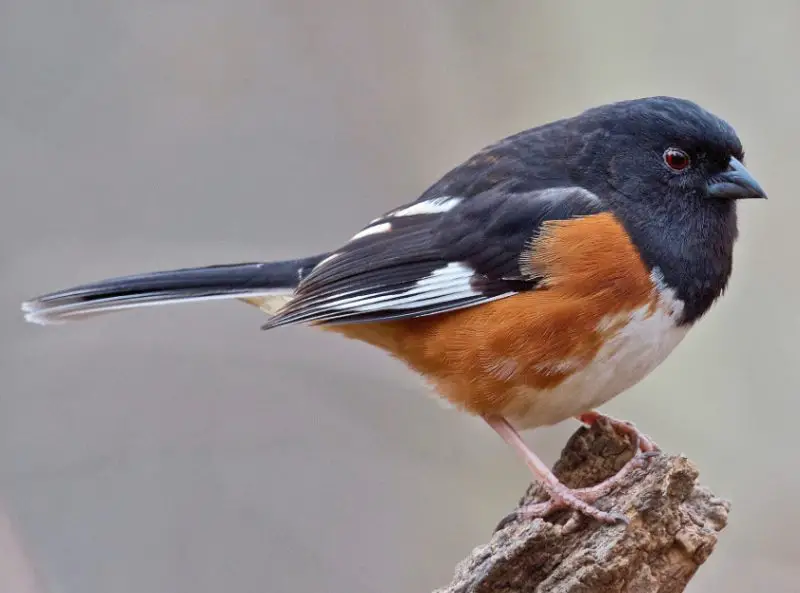
The Eastern Towhee is a striking sparrow-sized bird identified by its black upperparts, rufous sides, and white belly in males, while females are similar but brown where males are black. They measure about 6.5 to 8.2 inches long with a wingspan of 7.9 to 11 inches. Their long tails and bold plumage patterns make them stand out when foraging on the ground.
Towhees are ground feeders, often scratching in leaf litter with both feet to uncover insects, seeds, and berries. Their call sounds like a sharp “chewink,” and their song is often described as “drink-your-tea.” They are secretive birds, usually staying low in dense brush, but their bold markings catch the eye when they venture into the open.
In Delaware, Eastern Towhees are most common in shrubby habitats, woodland edges, and overgrown fields. They are present year-round, though some northern breeders may move into the state during winter. Their presence adds a splash of color and sound to Delaware’s thickets and hedgerows.
American Crow
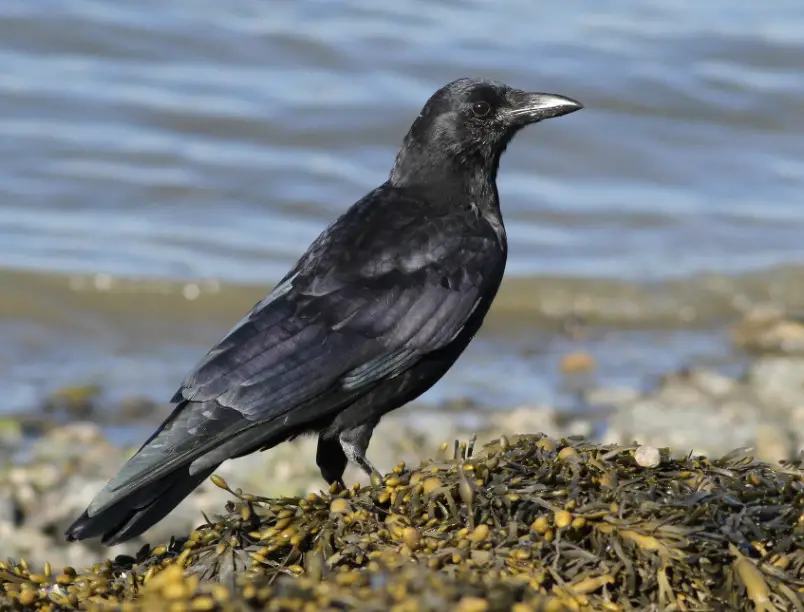
The American Crow is one of the most familiar birds across the United States, recognized for its glossy black feathers and loud cawing calls. Measuring about 16 to 20 inches in length with a wingspan of around 36 inches, this bird has a strong, stout build and a fan-shaped tail that makes it easy to identify in flight. Its intelligence is remarkable, with studies showing that crows can use tools and recognize human faces.
These birds are highly adaptable and thrive in a wide range of habitats, including farmlands, woodlands, suburban neighborhoods, and city centers. They are omnivorous, feeding on grains, insects, small animals, carrion, and even garbage, which makes them common in both rural and urban settings. Their opportunistic feeding habits contribute to their wide distribution and success.
American Crows are social creatures, often seen in large flocks, especially during roosting in the winter months. Their calls are not only a way to communicate but also serve as alarm systems to warn others of predators. They are also known to mob larger birds of prey to defend their territory or food sources.
Breeding season begins in early spring, when crows build large stick nests in tall trees. Both parents help raise the young, and sometimes offspring from previous years assist in caring for the new brood. This cooperative behavior demonstrates their complex social structures and intelligence.
Fish Crow
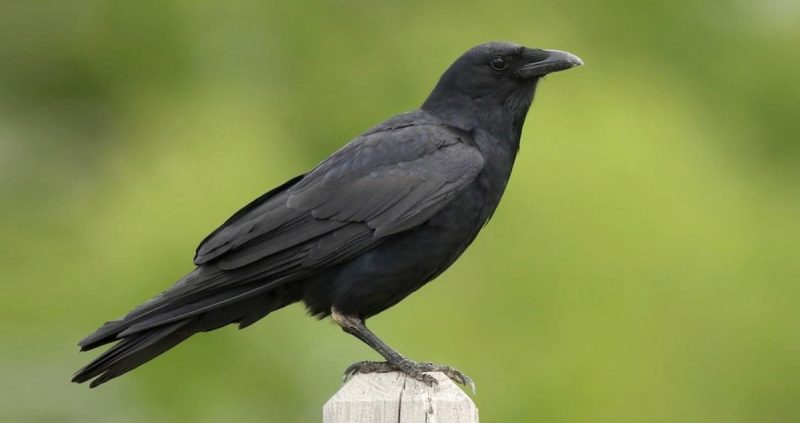
The Fish Crow is a smaller relative of the American Crow, measuring about 14 to 16 inches in length with a wingspan of 28 to 30 inches. At first glance, it looks almost identical to the American Crow, but it can be distinguished by its nasal-sounding “uh-uh” call, which sets it apart. Its plumage is entirely black with a slight iridescent sheen, similar to its larger cousin.
This bird is commonly found in coastal areas, river valleys, and wetlands, where it feeds on fish, crustaceans, carrion, and other small animals. Despite its name, the Fish Crow does not rely solely on fish and will also consume fruits, grains, and garbage when available. Its adaptability in diet helps it survive in diverse environments.
Fish Crows are particularly abundant in the southeastern United States but their range is expanding northward. They are often seen flying along waterways, foraging in groups, or perching in trees near rivers and lakes. Their association with aquatic habitats makes them less common in dry inland regions.
During breeding season, Fish Crows build their nests high in trees, often in wooded swamps or riverbanks. They are social birds and may nest in loose colonies. Like other crow species, they are intelligent and capable of problem-solving behaviors, which aids in their survival.
Turkey Vulture

The Turkey Vulture is a large soaring bird with a wingspan of up to 72 inches, making it one of the most common vultures in North America. Its dark brown body, broad wings, and distinctive red featherless head make it easy to recognize. In flight, it can be identified by its teetering, V-shaped wing posture and light-colored wing undersides.
This scavenger plays an important ecological role by feeding on carrion. Unlike most birds, Turkey Vultures have a highly developed sense of smell that allows them to detect decaying animals from great distances. They rarely kill live prey, instead relying on their excellent soaring ability to cover wide areas in search of food.
Turkey Vultures inhabit open areas such as farmland, deserts, forests, and grasslands. They are especially common in rural landscapes and can often be seen gliding effortlessly in groups, taking advantage of rising thermals. Their flight style helps conserve energy as they spend much of the day searching for food.
Breeding occurs in spring, with females laying eggs in sheltered sites like caves, hollow trees, or abandoned buildings. Turkey Vultures do not build traditional nests; instead, they lay eggs directly on the ground or substrate. The chicks are fed by regurgitation until they are old enough to fledge.
Black Vulture
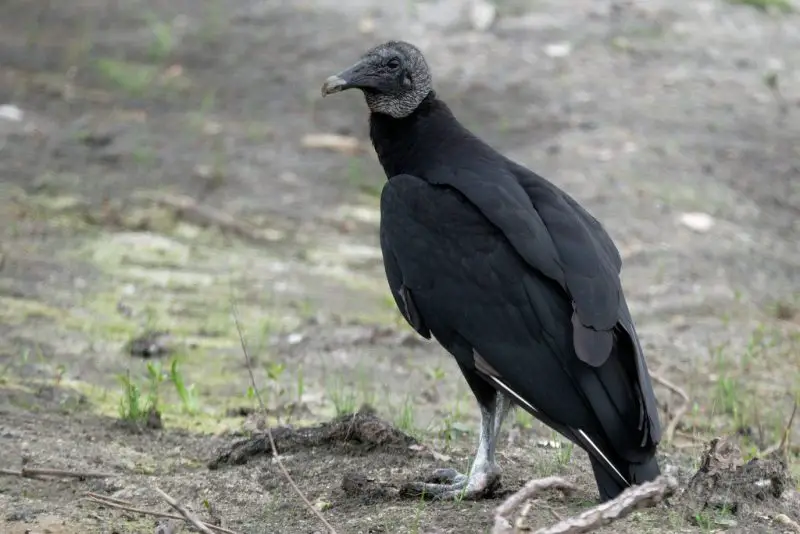
The Black Vulture is a stocky scavenger that is smaller than the Turkey Vulture but equally widespread in the southeastern United States. It has black plumage, a short square tail, and white patches at the tips of its wings that are visible in flight. Its gray, wrinkled featherless head gives it a distinct appearance compared to the red-headed Turkey Vulture.
Unlike the Turkey Vulture, the Black Vulture has a poor sense of smell and relies more on sight to locate food. They are often seen following Turkey Vultures to find carrion, and they sometimes hunt small animals or raid nests for eggs. Their stronger bills allow them to tear through tougher carcasses than Turkey Vultures can.
Black Vultures prefer open areas, farmland, and forest edges, often roosting in large communal groups. They can be aggressive around food sources, sometimes driving away Turkey Vultures despite their smaller size. Their social nature makes them more likely to forage and travel in groups compared to the more solitary Turkey Vulture.
During the breeding season, Black Vultures lay two eggs in concealed locations such as hollow logs, caves, or abandoned structures. Both parents share incubation duties and feeding responsibilities by regurgitating food for their young. Their cooperative breeding behavior is a defining trait of the species.
Red-tailed Hawk
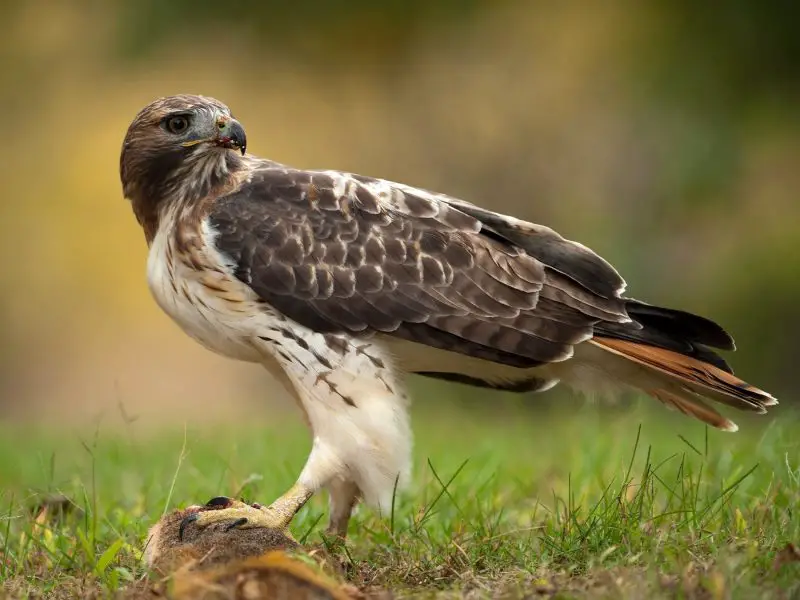
The Red-tailed Hawk is one of the most widespread raptors in North America and is easily identified by its broad wings and distinctive reddish-brown tail. Adults typically measure 18 to 26 inches in length with a wingspan of 43 to 57 inches. Their plumage varies widely in color, from pale to dark morphs, but the red tail is a key field mark in adults.
These hawks are powerful hunters, preying on rodents, rabbits, reptiles, and birds. They rely on sharp vision to detect prey from high perches or while soaring. Once spotted, they swoop down swiftly to capture their meal with strong talons. Their adaptability in diet allows them to thrive in diverse ecosystems.
Red-tailed Hawks are commonly found in open habitats such as fields, deserts, woodlands, and along highways where they perch on poles. They are year-round residents in most of the United States, often seen circling high in the sky or perched prominently while hunting. Their iconic raspy scream is frequently used in movies as the stereotypical “hawk call.”
Nesting usually takes place high in trees or on cliffs, where they build large stick nests reused year after year. Pairs are monogamous and often remain together for life, fiercely defending their territory during the breeding season. Their strong presence makes them one of the most observed raptors across the continent.
Cooper’s Hawk
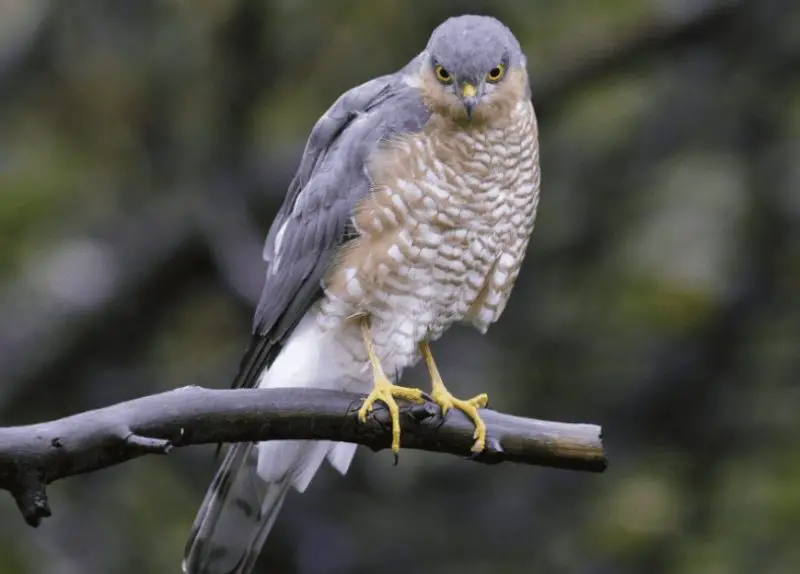
The Cooper’s Hawk is a medium-sized raptor that belongs to the Accipiter family, known for its short, rounded wings and long tail. Adults measure 14 to 20 inches in length with a wingspan of 24 to 39 inches. They have blue-gray backs, reddish-barred chests, and a rounded tail tipped with white. Their sharp features and piercing eyes make them easy to distinguish.
These hawks are agile hunters, specializing in chasing birds through dense forests and suburban backyards. Their flight style includes quick flaps followed by short glides, allowing them to maneuver skillfully through trees while pursuing prey. They primarily feed on pigeons, doves, songbirds, and small mammals.
Cooper’s Hawks are found in woodlands, forest edges, and urban areas, where bird feeders often attract their prey. They are stealthy predators and sometimes surprise birdwatchers when they swoop into backyards to snatch an unsuspecting songbird. Despite their predatory nature, they play an important role in maintaining ecological balance.
Breeding pairs construct stick nests in tall trees, often reusing old nests from crows or squirrels. Both parents share in raising the chicks, with males providing most of the food while females guard the nest. Their fierce defense of territory and young during nesting season demonstrates their strong survival instincts.
Sharp-shinned Hawk
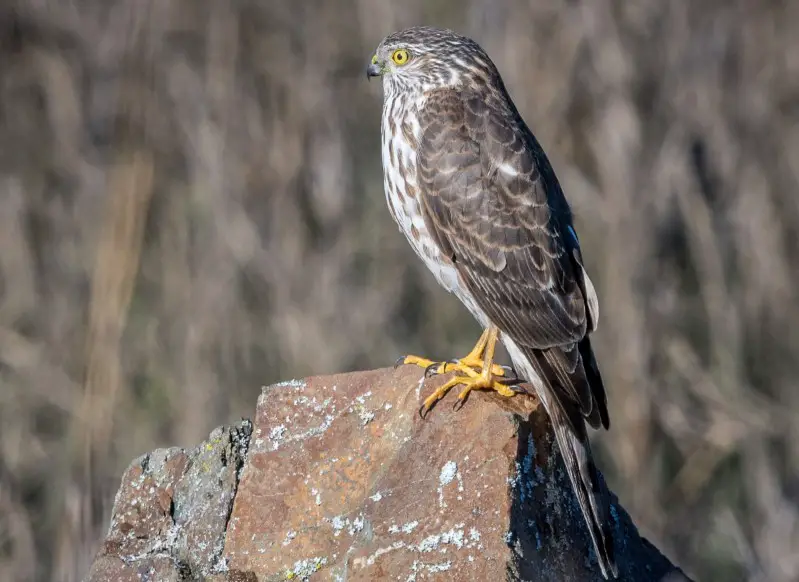
The Sharp-shinned Hawk is the smallest hawk in North America, measuring about 9 to 13 inches long with a wingspan of 16 to 22 inches. It has short, rounded wings and a long, narrow tail with square edges, helping it maneuver quickly through dense woods. Adults have bluish-gray upperparts and reddish-barred underparts, while juveniles show brown streaking on the chest.
This hawk is a secretive hunter, often ambushing songbirds at feeders or darting swiftly through forests. It relies on speed and agility rather than soaring high in open skies, making it a frequent but fleeting sight. The species is often confused with the slightly larger Cooper’s Hawk, but its square tail and smaller head help with identification.
Sharp-shinned Hawks prefer wooded habitats, particularly coniferous forests, but they are also seen in suburban areas with bird feeders. In winter, they migrate south across much of the United States, while northern breeders retreat from Canada. Their adaptability allows them to thrive in various landscapes where small birds are abundant.
A fun fact about Sharp-shinned Hawks is that females are significantly larger than males, sometimes by up to a third in size. This size difference helps reduce competition for food between the sexes, with females often preying on larger birds while males focus on smaller ones.
Great Horned Owl

The Great Horned Owl is one of the most iconic raptors in North America, instantly recognizable by its tall ear tufts and large yellow eyes. It measures 18 to 25 inches long with a wingspan of 3 to 5 feet, making it one of the largest owls in Delaware. Its plumage is mottled brown and gray, providing excellent camouflage against tree bark.
This owl is a powerful nocturnal hunter, feeding on mammals, birds, reptiles, and even skunks. It uses its incredible grip strength to crush prey instantly. Known for its deep, resonant hoots, the Great Horned Owl establishes strong territorial claims, especially during the breeding season in late winter.
It inhabits a wide range of environments, from forests and wetlands to suburban neighborhoods. In Delaware, it is a year-round resident and can be spotted at dawn or dusk perched along woodland edges or near open fields. Its adaptability makes it one of the most widespread owls in North America.
A fun fact about the Great Horned Owl is that it cannot smell, which allows it to hunt skunks without being bothered by their defensive spray. This unique ability gives it access to a food source avoided by most other predators.
Barred Owl
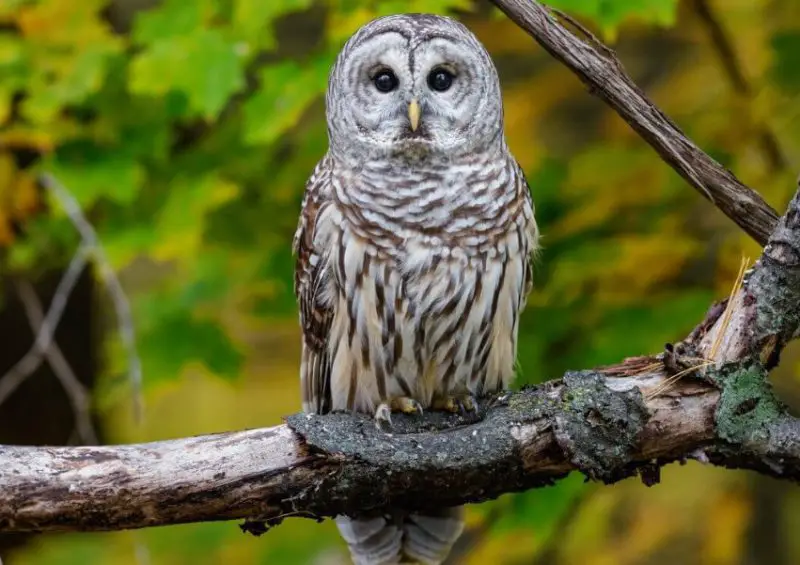
The Barred Owl is a large, stocky owl measuring about 16 to 24 inches long with a wingspan of 39 to 44 inches. It has brown-and-white striped plumage across its chest and belly, earning its name “barred.” Its round head lacks ear tufts, and its dark brown eyes stand out against a pale facial disk.
This owl is most famous for its distinctive call that sounds like “Who cooks for you? Who cooks for you all?” It is primarily nocturnal but often calls during the day, especially in spring. Its diet includes small mammals, amphibians, reptiles, and occasionally fish, which it hunts silently using its excellent hearing and vision.
In Delaware, the Barred Owl inhabits mature forests, swamps, and wooded wetlands. It prefers areas with large trees near water, where it can find both nesting sites and abundant prey. Unlike some owls, it tends to stay in one area year-round.
A fun fact about the Barred Owl is that it has been expanding its range westward, where it sometimes competes with the endangered Spotted Owl. This expansion has created conservation challenges in certain regions.
Osprey
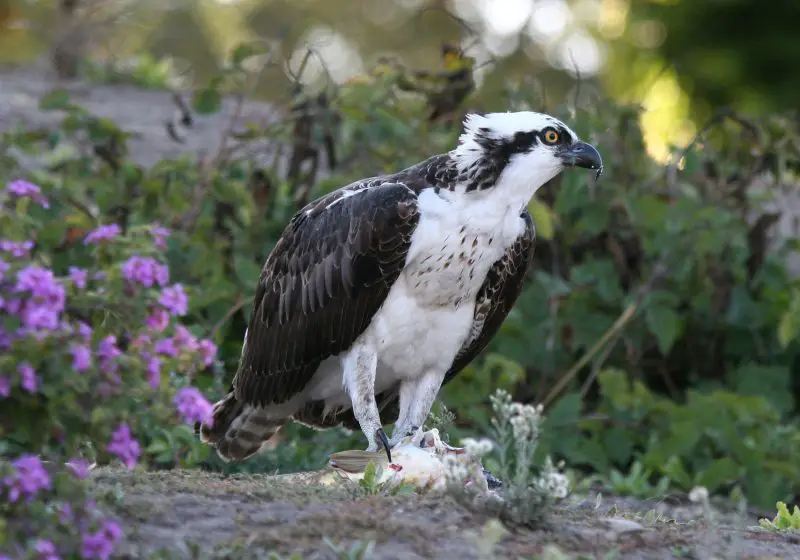
The Osprey is a large fish-eating raptor, measuring 21 to 23 inches long with a wingspan of up to 6 feet. It has dark brown upperparts, white underparts, and a distinctive dark eye stripe across its face. When in flight, its long wings show a characteristic crook, giving it an M-shaped silhouette.
This bird is a skilled hunter that feeds almost exclusively on fish. It plunges feet-first into the water to snatch its prey with sharp talons equipped with spiny pads for gripping slippery fish. Unlike most raptors, the Osprey can close its outer toes to hold fish with two toes in front and two behind, providing a secure grasp.
Ospreys are common summer residents in Delaware, nesting near rivers, marshes, and coastal waters. They build massive stick nests on tall structures such as utility poles, channel markers, or artificial platforms provided for conservation. Many migrate to Central and South America for the winter.
A fun fact about the Osprey is that it is one of the few raptors found on every continent except Antarctica, making it a truly global bird of prey.
Bald Eagle
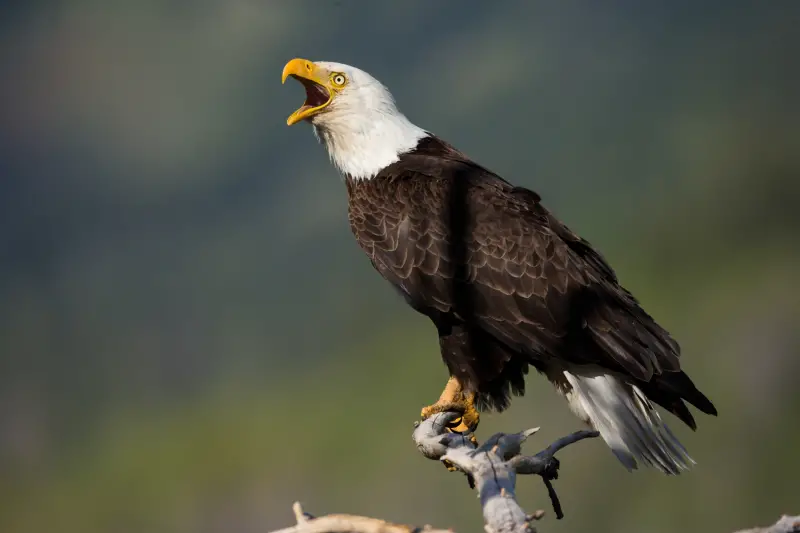
The Bald Eagle is a powerful bird and the national symbol of the United States. Adults are unmistakable with their white head and tail contrasting against dark brown bodies, while juveniles are mottled brown until they mature around age five. They measure 28 to 40 inches long with an impressive wingspan of 6 to 7.5 feet.
These eagles primarily feed on fish but are also opportunistic scavengers, stealing food from other birds or feeding on carrion. They are skilled hunters that swoop down to snatch fish from the water with strong talons. Their piercing call and striking appearance make them one of the most admired raptors.
In Delaware, Bald Eagles are found year-round, particularly near large rivers, lakes, and coastal areas. Their nests, called eyries, are enormous and can weigh up to a ton after years of reuse and rebuilding. These nests are often placed high in tall trees, offering a wide view of surrounding waters.
A fun fact about the Bald Eagle is that its eyesight is four to eight times stronger than that of humans, allowing it to spot prey from great distances.
Killdeer
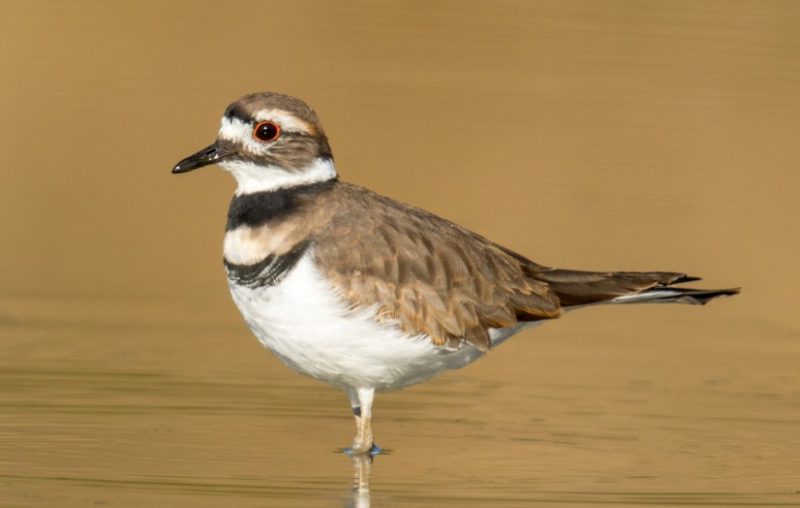
The Killdeer is a medium-sized plover, about 8 to 11 inches long with a wingspan of 18 to 23 inches. It has a brown back, white underparts, and two bold black bands across its chest. Its long legs and red-orange eye ring make it easy to recognize in open habitats.
Unlike many shorebirds, Killdeer are often found far from water. They thrive in fields, lawns, golf courses, and even parking lots. Their loud, high-pitched “kill-deer” call gives them their name and makes them one of the most vocal plovers in North America.
Killdeer are ground nesters, often laying eggs in gravel or bare soil where they blend perfectly with their surroundings. To protect their nests, they perform a dramatic “broken-wing” act, feigning injury to lure predators away from their eggs or chicks.
A fun fact about Killdeer is that their chicks can run and feed themselves within hours of hatching, a survival strategy that helps them avoid predators in exposed nesting areas.
Rock Pigeon
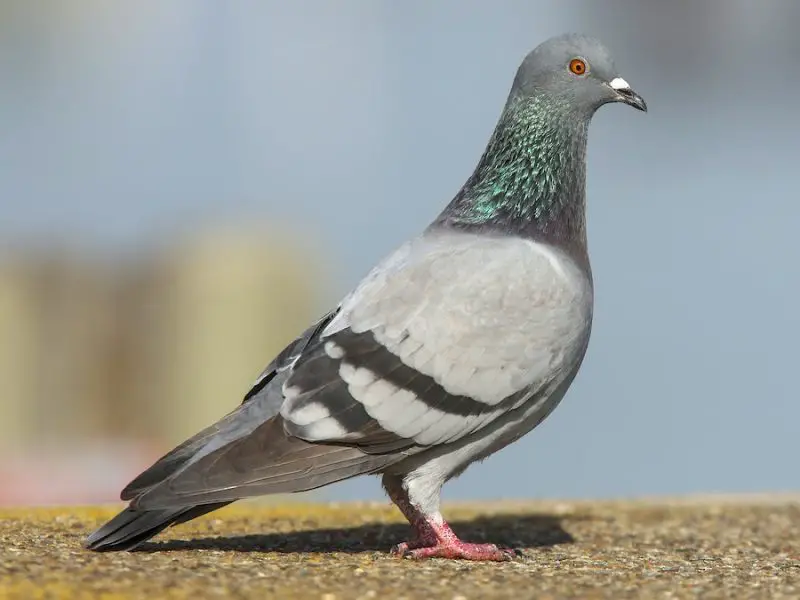
Rock Pigeons are medium-sized birds commonly found in cities and towns, often recognized by their bluish-gray bodies with iridescent green and purple feathers around the neck. Their wings are broad and pointed, usually marked with two black bars, and their tails are square-shaped with a dark band at the end. Measuring about 11 to 13 inches in length, they are stocky birds with short legs and a quick, powerful flight.
These birds are highly adaptable and often gather in large flocks, feeding on seeds, grains, and food scraps left by humans. Their strong homing instincts have made them historically valuable as messenger birds. Rock Pigeons are often seen walking along sidewalks, perched on building ledges, or flying in flocks across urban skies.
They thrive in a wide range of habitats but are most commonly associated with human settlements. Native to Europe, North Africa, and South Asia, they have been introduced worldwide and are now a familiar sight in Delaware. They nest on building ledges, bridges, and cliffs, laying one to two eggs that both parents incubate.
House Sparrow
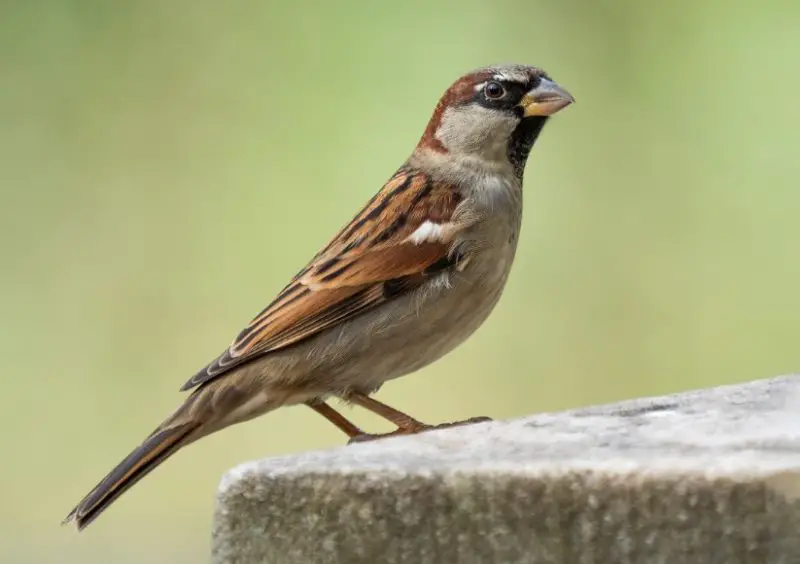
The House Sparrow is a small, chunky bird about 6 inches long, with a thick bill and short tail. Males have gray heads, white cheeks, and a black bib that varies in size with age and status. Females and young birds are more plain, with brown backs streaked with black and lighter underparts. Their appearance makes them easy to identify among other backyard birds.
House Sparrows are highly social and often gather in noisy flocks around homes, gardens, and city streets. They primarily eat grains, seeds, and scraps but will also feed insects to their young. Males often chirp persistently near nesting sites, which are usually tucked into crevices of buildings or birdhouses.
Though not native to North America, House Sparrows were introduced from Europe in the 1800s and quickly spread across the continent. They are year-round residents in Delaware and can be found in both rural and urban areas. Their adaptability allows them to thrive near people, though they sometimes compete with native species for nesting sites.
Chimney Swift
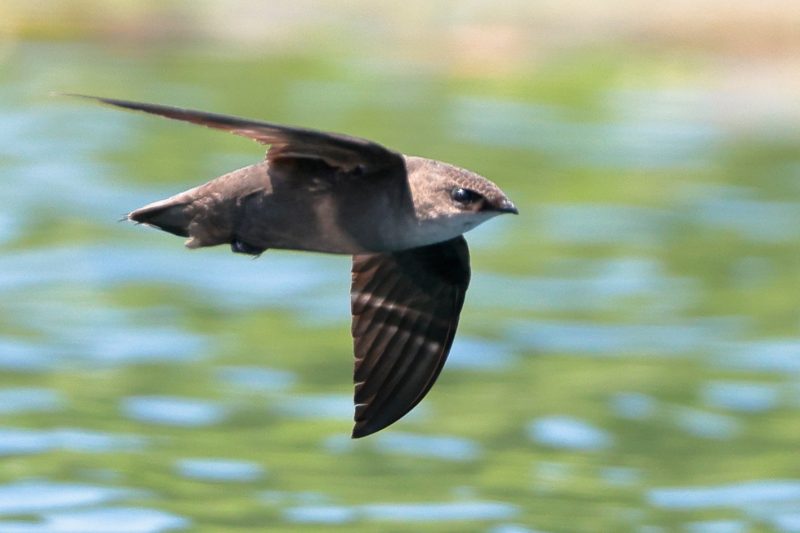
Chimney Swifts are small, fast-flying birds with slender, cigar-shaped bodies and long, narrow, curved wings. Their plumage is sooty gray-brown, and their short, squared tails make them appear almost tailless in flight. They are about 5 inches long and are most often seen darting through the sky in quick, fluttering movements.
These birds are aerial insectivores, spending nearly their entire lives in flight as they feed on flying insects. They cannot perch upright like most birds, instead clinging vertically to rough surfaces such as brick, stone, or tree bark. Their high-pitched chattering calls often give away their presence near nesting sites.
Chimney Swifts are migratory and spend the breeding season in the eastern United States, including Delaware. They build their nests inside chimneys, barns, or hollow trees, using twigs glued together with their sticky saliva. By late summer, they gather in large groups before migrating to South America for the winter.
Ruby-throated Hummingbird
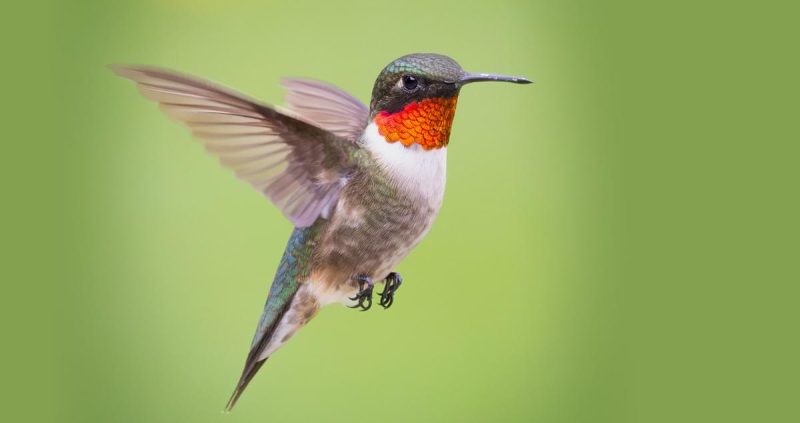
The Ruby-throated Hummingbird is a tiny bird, measuring about 3 to 3.5 inches long, with iridescent green upperparts and a white underside. Males are instantly recognizable by their brilliant ruby-red throat, which can appear dark depending on the light. Females lack the red throat and have more muted colors. Their long, slender bills are perfectly adapted for sipping nectar.
They are agile fliers capable of hovering in mid-air, flying backward, and darting quickly from flower to flower. Nectar is their main food source, but they also consume small insects and spiders for protein. The rapid beating of their wings, up to 53 times per second, creates a distinctive humming sound.
Ruby-throated Hummingbirds are the only breeding hummingbird species in eastern North America. In Delaware, they arrive in spring to breed and depart by early fall for their migration to Central America. They often visit backyard feeders filled with sugar water, as well as gardens rich in tubular flowers.
Barn Swallow
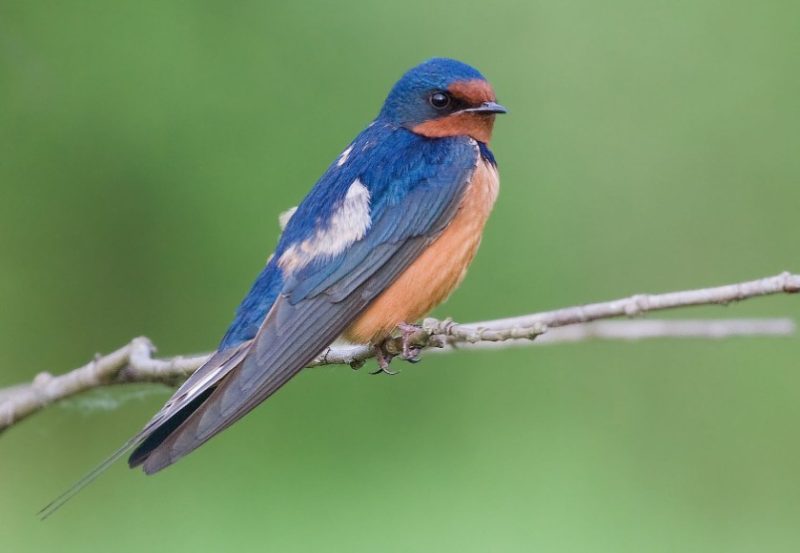
Barn Swallows are graceful birds with long, deeply forked tails and sleek bodies. Their upperparts are glossy blue, while their underparts are cinnamon-colored, with a rusty throat and forehead. They measure about 7 inches in length and are easily recognized by their elegant, sweeping flight patterns.
These swallows are skilled aerial hunters, feeding almost exclusively on flying insects such as flies, mosquitoes, and beetles. They often skim low over fields, water, and open areas as they catch prey midair. Their constant chattering calls are often heard as they fly overhead.
Barn Swallows build their mud-cup nests on man-made structures such as barns, bridges, and porches. They are common summer residents throughout Delaware, arriving in spring and leaving by fall to migrate to South America. Their presence is often associated with rural landscapes and open countryside.
Tree Swallow
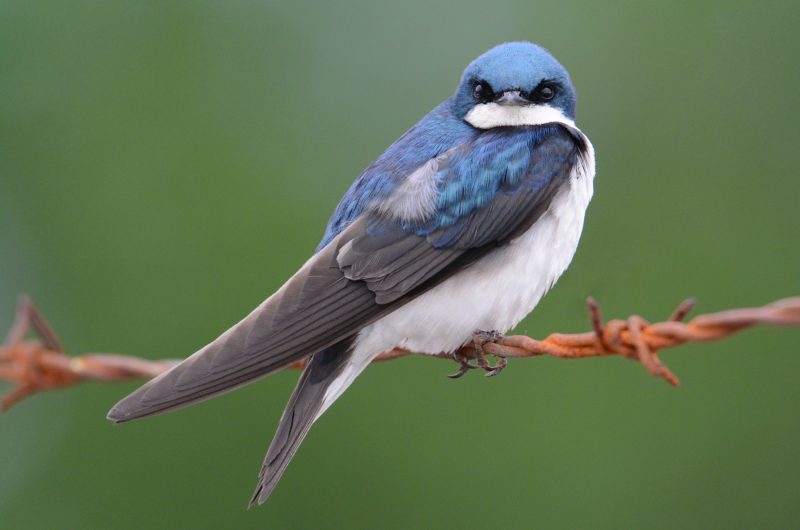
Tree Swallows are small, sleek birds about 5 to 6 inches long, with shiny blue-green upperparts and clean white underparts. Their wings are long and pointed, and their tails are slightly forked. In flight, they appear agile and graceful, gliding and swooping effortlessly through the air.
These birds primarily feed on flying insects, though they also eat berries, especially in cooler weather when insects are scarce. Tree Swallows are cavity nesters, often using old woodpecker holes or nest boxes. They are highly social, often nesting in loose colonies and forming large flocks during migration.
In Delaware, Tree Swallows are common during the breeding season and can be found near wetlands, fields, and open areas with access to water. They migrate south in large flocks during the fall, spending the winter in the southern United States, Mexico, and Central America. Their presence in early spring is often a welcome sign of the changing seasons.
Belted Kingfisher

The Belted Kingfisher is a striking bird recognized by its large head, shaggy crest, and strong bill built for fishing. Males are mostly blue-gray with a white collar and belly, while females are more colorful, showing a chestnut band across the chest in addition to the blue. Their loud, rattling call often announces their presence before they are seen flying swiftly over rivers and lakes.
This bird is most often found near freshwater streams, ponds, and estuaries, where it perches on branches overlooking the water. It dives headfirst with precision to catch fish, using its sharp beak to snatch prey. Kingfishers dig burrows into sandy banks to nest, often several feet deep, providing safe places for their young.
In Delaware, Belted Kingfishers are commonly observed year-round along waterways and coastal marshes. They are particularly active during warmer months when fish are abundant. Their adaptability and distinct hunting style make them one of the most recognizable water-associated birds.
Great Blue Heron
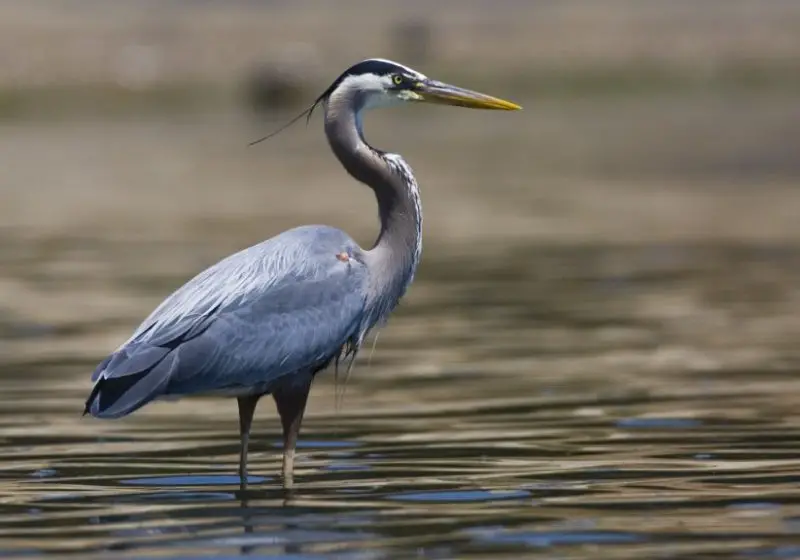
The Great Blue Heron is the largest heron in North America, standing over 4 feet tall with a wingspan up to 6 feet. Its long neck, dagger-like bill, and slate-blue plumage make it unmistakable. Despite its size, it flies gracefully with slow wingbeats and its neck tucked into an “S” shape.
These herons are patient hunters, often seen wading slowly through shallow water before striking swiftly at fish, frogs, and even small mammals. They usually feed alone but gather in colonies, called rookeries, for nesting. Nests are built high in trees, often in wetlands or along rivers.
In Delaware, Great Blue Herons are present year-round and are especially common in marshes, ponds, and coastal areas. They are admired for their elegance and adaptability, thriving in both freshwater and saltwater habitats. Their presence is often a sign of a healthy wetland ecosystem.
Canada Goose
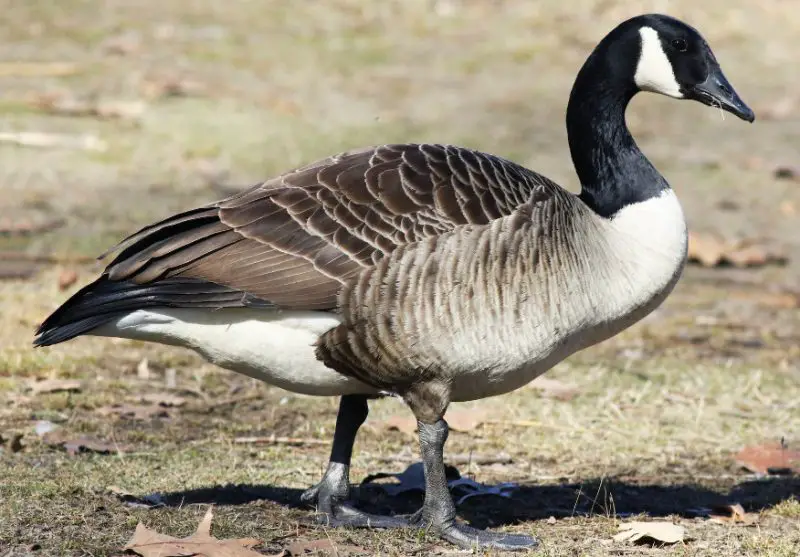
The Canada Goose is a familiar sight with its black head and neck, white cheek patch, and brown body. Known for its loud honking calls and V-shaped flying formations, this species is both admired and sometimes considered a nuisance in urban areas due to its abundance.
Canada Geese are grazing birds that feed on grasses, grains, and aquatic plants. They are highly adaptable, thriving in farmlands, parks, lakes, and coastal marshes. During migration, their flocks are a symbol of changing seasons, especially in fall and spring.
In Delaware, Canada Geese are common year-round, with numbers peaking during migration periods. They often gather in large flocks near water and agricultural fields. Their resilience and adaptability ensure they remain one of the most widely recognized birds across North America.
Mallard
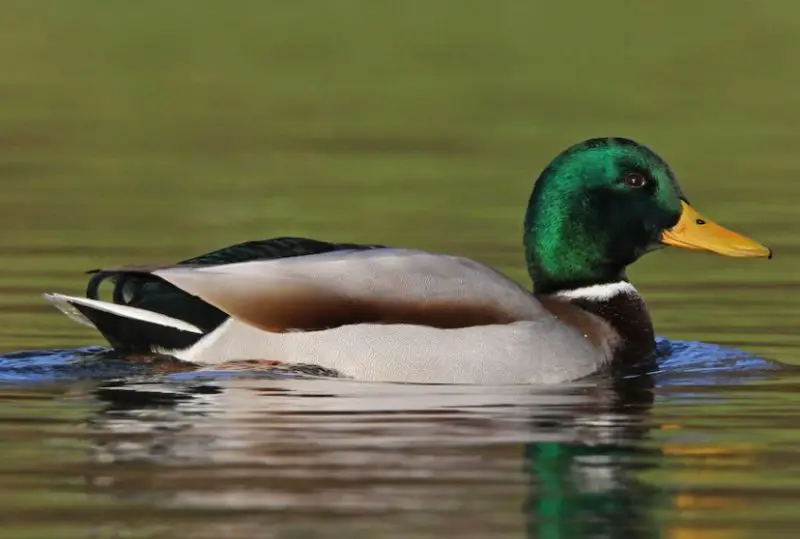
The Mallard is perhaps the most recognizable duck in the world. Males are striking, with iridescent green heads, yellow bills, and a curled black tail feather, while females are mottled brown with orange bills. Both sexes have a distinctive blue wing patch bordered by white.
Mallards are dabbling ducks, meaning they feed mainly at the water’s surface rather than diving. They eat a variety of foods including aquatic plants, insects, and grains. Known for their adaptability, they thrive in wetlands, ponds, rivers, and even city parks.
In Delaware, Mallards are widespread and can be seen year-round. They are also the ancestors of many domestic duck breeds, making them both ecologically and culturally significant. Their adaptability and boldness around people ensure they are one of the most frequently encountered waterfowl in the state.
FAQs About Common Birds in Delaware
What are the most common backyard birds in Delaware?
Some of the most frequently seen backyard birds include Northern Cardinals, American Robins, Blue Jays, Mourning Doves, and House Finches. These species are adaptable and often thrive near human habitation.
When is the best time to see birds in Delaware?
Spring and early summer are ideal for observing breeding and migratory birds. Fall migration is also a good time to spot a variety of species passing through the state. Winter offers opportunities to see resident species and waterfowl at coastal areas and ponds.
Which birds are year-round residents in Delaware?
Birds such as the Northern Cardinal, Blue Jay, American Crow, and Mourning Dove remain in Delaware throughout the year. These species have adapted to local habitats and can survive the colder months.
Are there any rare or unusual birds in Delaware?
Yes, Delaware occasionally hosts rare visitors like Ospreys, Bald Eagles, and migratory warblers. Coastal areas, wetlands, and forest edges are the best places to encounter these less common species.
What types of habitats support the most bird diversity in Delaware?
Wetlands, forests, meadows, and coastal areas support high bird diversity. Urban parks and suburban gardens can also attract numerous species, especially with feeders and native plants.
How can beginners identify birds in Delaware?
Beginners should focus on size, shape, color patterns, beak type, behavior, and habitat. Using a field guide, binoculars, and birding apps can make identification easier and more accurate.
Do Delaware birds migrate?
Many birds in Delaware migrate seasonally. Songbirds, warblers, and hummingbirds often travel south for the winter, while waterfowl may move between coastal and inland habitats depending on weather and food availability.
How can I attract more birds to my backyard?
Providing feeders with seeds, suet, or nectar, along with fresh water, native plants, and shelter, can attract a wide variety of birds. Planting shrubs and trees for cover and nesting also increases backyard bird activity.

